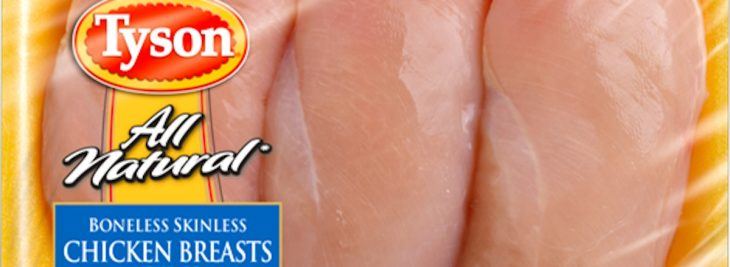Tyson Foods’ buy-versus-grow policy boosts chicken segment during period of price pressure
by November 24, 2015 2:40 pm 994 views

There was a time when chicken companies like Tyson Foods oversaw the growing of every bird slaughtered in its plants. But that came with an expensive fixed-asset cost, and Tyson execs now say buying some chicken instead of producing it all helps control costs and better manage supply and demand.
Tyson Foods CEO Donnie Smith said the company is buying about 100 truckloads of raw commodity chicken – about 862 million pounds – a week which it runs through its plants to fill orders for breast meat, some wings and occasionally chicken tenders which is processed and sent into food service and retail.
The 100 truckloads of chicken bought in the open market is a fairly substantial number compared to 40 million chickens it slaughters each week, Smith said the buy-versus-grow policy is a better strategy when poultry exports are often compromised by bird flu bans and other foreign trade hurdles. He said if Tyson grew all of the birds it needed to fill its white meat orders, there would be considerable dark meat left over with little or no market given that poultry exports for leg quarter dark meat are often mired in red tape. The alternative would be to sell the dark meat in the U.S. market for much lower prices than could be garnered if exported.
When chicken prices are weaker, Smith said Tyson’s buy-versus-grow policy gives it an advantage. The strategy began when grain prices were much higher than and the last thing the company needed were processed birds in cold storage when supply outpaced demand.
The buy-versus-grow strategy has helped the company improve margins in the chicken segment. The company on Monday (Nov. 23) reported fiscal year total sales (unadjusted) in the segment were $11.39 billion, up 4.2% compared to the 2014 fiscal year. However, operating income in the segment for the fiscal year was $1.366 billion, up almost 55% compared to the same period in 2014.
FREQUENT CHICKEN GLUT
The poultry industry has long been known for overproducing chicken at times when demand, margins and prices are high, only to suffer losses when an export market like Russia closes. In the past year, the industry has been too exuberant with production and prices have softened because of excess supply – with most of the export markets for dark meat shut off from the Avian Influenza outbreak which began earlier this year.
The chicken cutout price (the sum value of all the parts) is at its lowest level in five years, thanks in part to low grain costs fueling more production while exports remain challenged. Wholesale chicken prices for boneless, skinless breast meat based on Georgia Dock pricing was $1.53 a pound this week. One year ago the same cut of meat was priced at $1.96 per pound, or nearly 22% more expensive at wholesale. Leg quarters, which are mostly exported, were $52 cents a pound this time last year, compared to 37.5 cents this week on the Georgia Dock price list. This is a 38.6% price difference year-over-year.
Analysts applaud Tyson’s effort to buy chicken parts like breast, tenders and wings it can process into higher margin items by marinating, breading or cooking. This strategy has served the company well this year because there is virtually no export market for dark meat. Tyson competitors also are trying to wean themselves from export dependency and low margin business.
Pilgrim’s Pride recently noted in its earnings release that continued challenges in the export market, the strong dollar and the lowest chicken prices in five year weighed heavily on its third quarter earnings. Net income in the quarter was $137.095 million, down more than 46% compared to the same period in 2014.
Pilgrim’s CEO Bill Lovette said even through he expects export markets to reopen soon, the company is looking for solutions to reduce its dependencies on commodity products as it too, looks to add more higher-margin items to its portfolio.
Smith was asked if the buy-versus-grow policy negatively impacts poultry growers who supply Tyson Foods with chicken. Smith said Tyson’s strategy is managed by forecasting demand out 12 to 18 months, and then using that info to change the production cycle by giving poultry farmers more time in between flocks. Smith said this is essential for litter management required by the company. He said growers typically are now getting an extra week between flocks to better manage the litter.
ANTIBIOTIC FREE
Talk Business & Politics also asked Tyson Foods for an update on its antibiotic free chicken. Smith said out of the 40 million birds it slaughters each week, roughly 800,000 are part of the antibiotic free program. The birds are not part of the buy-versus-grow program but they are one way Tyson Foods is focusing on consumer demands.
Smith said it’s a relatively small part of the overall production, but continues to be one of the fastest growing. He said chicken from the antibiotic free program is processed and then distributed into food service and retail channels. He said the demand for antibiotic free chicken continues to grow and Tyson will expand the program as needed .
Consumers polled by NPD Group earlier this year said they would be willing to pay more for chicken raised without antibiotics, with up to 40% willing to pay as much as $1 more per pound for that guarantee.
